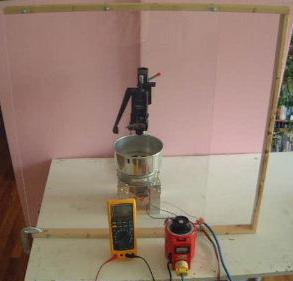Sept 27-30, 2004 - Mounting of the rotating conductor and some tests
Using this arrangement, at about 1820 RPM the unit begins to move across the table due to vibration. It is still quiet at that point. I've managed to get 3400 RPM at 3 Amps. The reason this is a limit is that this is the size of the fuse in my variac. Due to vibration on the table it is very noisy at this speed.
|
| ||
|
|
| ||
|
|
|
Oct 15-29, 2004 - Making the electrodes
The Stationary Electrode
The stationary electrode was made by getting a fabrication shop to roll two alluminum strips of metal into two 3/4 cylinders. I then cut each to the length of a 1/2 cylinder and taped them together using aluminum tape to make a single cylinder.
The next step was to make the edges be rounded while also ensuring that the electric field would not be densest at the edges. To do this I used resin to glue 1/4" diameter nylon tubes to the outside top and bottom edges of the cylinder. To make the result conductive, I sprayed them with nickel spray. The spray I used was Super Shield Conductive Nickel Coating from M.G. Chemicals. I then attached a wire and coated the whole thing in resin. The pictures below illustrate this.
|
|
| ||
|
|
|
The Rotating Electrode
The original rotating electrode was a cooking pot with a lip sticking outward at the top. I cut the lip off but was now left with a sharp edge. To get rid of the sharp edge I did the same sort of thing as illustrated for the stationary electrode as described above but put the nylon tube on the inside instead.
|
|
The Electrodes together
|
|
Nov 22, 2004 - Added mounting pieces
|
|


